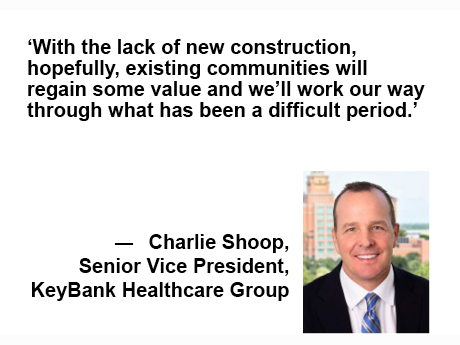The health of seniors housing occupancy continues to recover, albeit slowly, amid challenges that refuse to relent.
Rather than a one-two punch, the sector has absorbed a one-two-three combination: Occupancy-reducing COVID landed the first blow, labor shortages and inflating operational expenses delivered the second, and rising interest rates scored with the third, declares Charlie Shoop, a senior vice president with KeyBank’s healthcare group. A slumping economy may add a kick to the teeth for good measure.
“There is a lot of noise in seniors housing financials right now, and few properties or portfolios are sitting at full stabilization,” he states. “Those that are stabilized are obviously attracting a lot of interest from investors and lenders. But given the current economic and geopolitical environment, we’re in an unprecedented time.”

Peter Trazzera, KeyBank
The benchmark U.S. 10-Year Treasury yield of around 3.6 percent (at the time of this writing) has more than doubled since the beginning of the year, which is fueling expectations that cap rates will eventually rise. Amid these volatile conditions, investors have become much more discerning or have largely moved to the sidelines as they wait for sellers to adjust to the new price environment.
“There is money out there actively looking at deals, but ultimately many buyers are deciding that pricing is too rich and deals won’t pencil out given the higher interest rates and the return needs of equity providers,” points out Peter Trazzera, vice president with KeyBank Real Estate Capital. “We just haven’t seen a lot of sellers move off of their expectations.”
Bridge Solution
That’s not to say that debt and equity sources have lost enthusiasm for seniors housing, Shoop notes. Fannie Mae and Freddie Mac remain active in the sector, as does the Department of Housing and Urban Development (HUD), and are bullish on the long-term prospects of the industry. Of note, seniors communities often score well in the Agencies “affordability” scorecard, further enhancing lending interest. But all three agencies have underwritten deals more conservatively since the onset of the COVID pandemic and more recently in light of ongoing labor and expense challenges.
Historically, Fannie Mae and Freddie Mac loans provided leverage of up to 75 percent of value for seniors housing properties. But now that loan-to-value metric is reserved for only the high-end and best-performing communities owned by the strongest financial sponsors, Shoop says, as higher interest rates combined with debt service coverage ratio requirements are constraining the amount of proceeds lenders can provide.
Given the higher interest rate environment, full loan (loan-to-value [LTV]/loan-to-cost [LTC]) financings will be challenged in the near term until valuations are reset via higher capitalization rates. That has created a greater need for bridge loans to buy sponsors more time to improve their fundamentals, implement rate increases and stabilize operations in order to secure permanent financing, Shoop adds.
“Some of the liquidity for permanent debt has come out of the marketplace as stabilization is often taking a couple more years than originally thought,” he explains. “Bridge lenders are having to step in and provide that capital, whether it’s to replace construction loans or to refinance other bridge loans that were underwritten to be ready for the permanent market by now. But they’re not.” And while overall merger and acquisition activity has been robust during the first half of 2022, it is expected to wane as valuations and investor returns adjust to the higher interest rate environment.
Bridge loans have become more expensive, too, however. The benchmark secured overnight finance rate (SOFR) has risen to 2.96 percent from virtually zero at the beginning of the year. Still, KeyBank typically makes seniors housing bridge loans with planned future permanent financing from the agencies and underwrites to that end, Trazzera says. To date, it has continued to do so without having to significantly reduce the proceeds of its short-term loans.
“Given the cost of capital, we are very focused on ensuring adequate cash flow through sensitivity analyses and stress tests on interest rates through the stabilization of the property,” he states. “If rates were to increase, we may need to build in other structure to make sure borrowers maintain their credit profile.”
Some short-term borrowers that encountered difficulties during the pandemic are just now securing permanent loans. In a recent deal, KeyBank was able to lock in a permanent Fannie Mae loan for a 2019 bridge loan with KeyBank where the sponsor experienced stabilization delays due to admission restrictions and a hesitancy among seniors to move into facilities in general, Trazzera says.
“We worked with the borrower throughout the pandemic and went through multiple modifications to get the community through its challenges. None of these issues were really the borrower’s fault, and we concentrated our efforts to modify terms throughout the pandemic, allowing the borrower to focus on caring for its existing residents and leasing up the community,” he adds. “The financing market is certainly not shut down, but people are having to work through situations to find solutions.”
Signs of Recovery
The higher cost of bridge loans has added one more complication to the lives of developers, who were already navigating a sea of higher labor and construction costs as well as shortages of building materials and furnishings. While some material costs have retreated from their highs several months ago, they’re still well above their pre-pandemic levels.
“Developers are in somewhat of a weird spot — costs are coming down but interest rates are going up and inflation is still in the 8 percent range,” Trazzera says. “If you add in the supply chain issues, I don’t know if we’ve ever seen this environment before. However, folks are getting deals done.”
The trying development climate does have a silver lining that could help fuel recovery, however. Long-term fundamentals remain positive and lenders like KeyBank remain bullish on the seniors housing industry. Demand for housing continues to outweigh supply, and construction starts in the second quarter hit their weakest level in seven years, according to the National Investment Center for Seniors Housing and Care (NIC).
Additionally, in response to inflation, many seniors housing operators have been able to raise their rental rates, and revenues should continue to improve through the remainder of 2022 and into 2023, Trazzera adds. Indeed, seniors housing rents grew 7.1 percent in the first half of 2022, reports NIC.
While the ability to pass on those types of rent increases will eventually wane, operators are hoping that changes underway will help lead to more stability. In some cases, they are increasing wages and deploying new labor strategies to reduce the more exorbitant costs associated with hiring temporary agency workers, especially at skilled nursing facilities.
“The seniors housing industry is in a transitional period, but there are positives from both the revenue and expense side of the business,” Shoop says. “With the lack of new construction, hopefully, existing communities will regain some value and we’ll work our way through what has been a difficult period.”
— By Joe Gose. This article was written in conjunction with KeyBank Real Estate Capital, a content partner of Seniors Housing Business.

